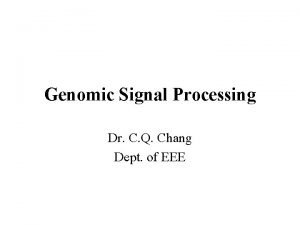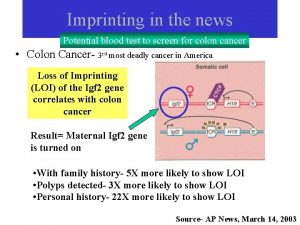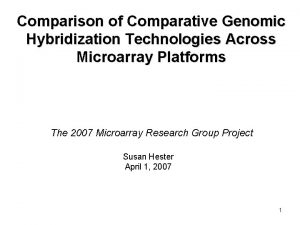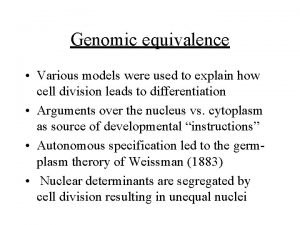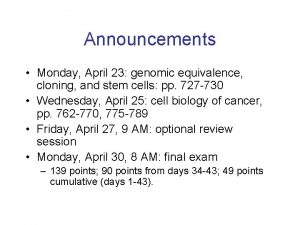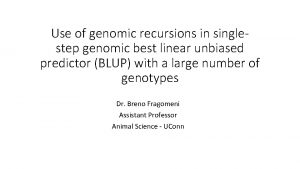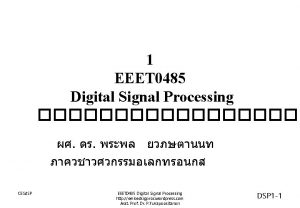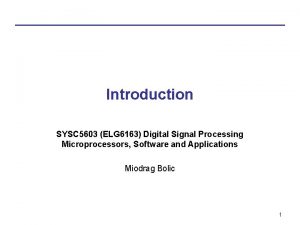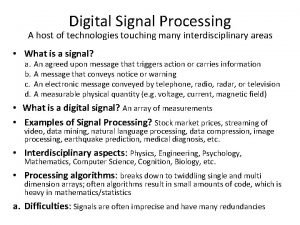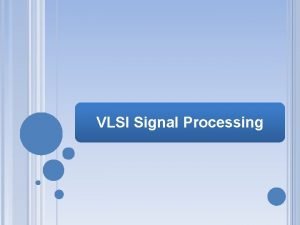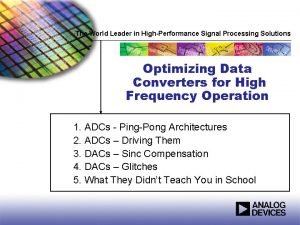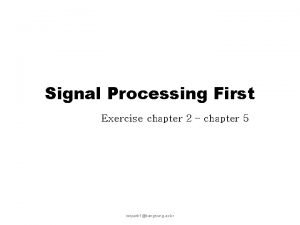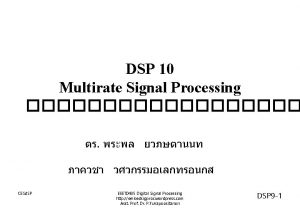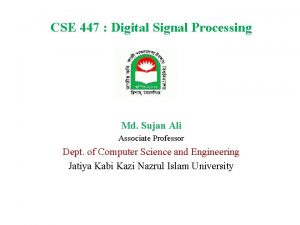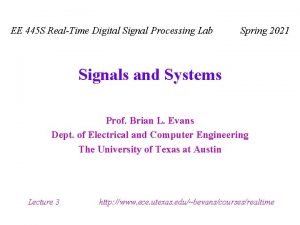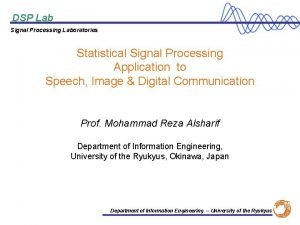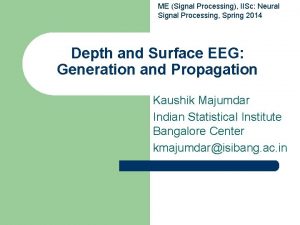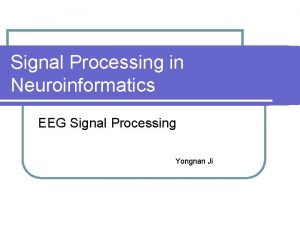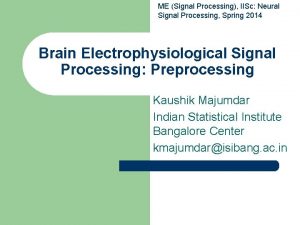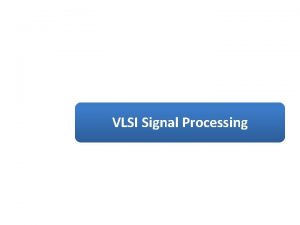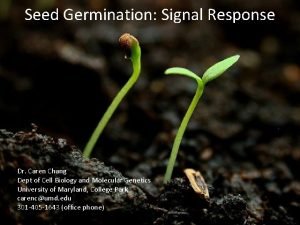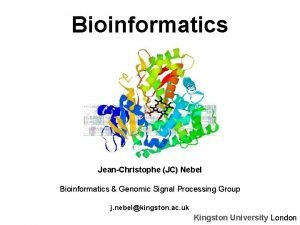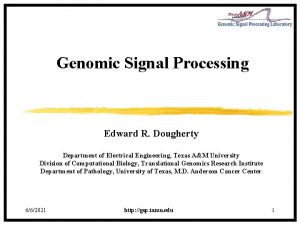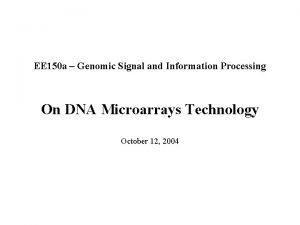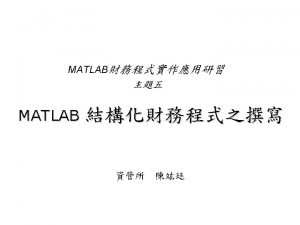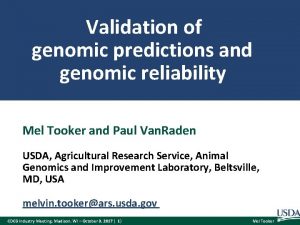Genomic Signal Processing Dr C Q Chang Dept






















- Slides: 22

Genomic Signal Processing Dr. C. Q. Chang Dept. of EEE

Outline • • • Basic Genomics Signal Processing for Genomic Sequences Signal Processing for Gene Expression Resources and Co-operations Challenges and Future Work

Basic Genomics

Genome • Every human cell contains 6 feet of double stranded (ds) DNA • This DNA has 3, 000, 000 base pairs representing 50, 000100, 000 genes • This DNA contains our complete genetic code or genome • DNA regulates all cell functions including response to disease, aging and development • Gene expression pattern: snapshot of DNA in a cell • Gene expression profile: DNA mutation or polymorphism over time • Genetic pathways: changes in genetic code accompanying metabolic and functional changes, e. g. disease or aging.


Gene: protein-coding DNA CCTGAGCCAACTATTGATGAA transcription m. RNA CCUGAGCCAACUAUUGAUGAA translation Protein PEPTIDE

In more detail (color ~state)

Signal Processing for Genomic Sequences

The Data Set

The Problem • Genomic information is digital letters A, T, C and G • Signal processing deals with numerical sequences, character strings have to be mapped into one or more numerical sequences • Identification of protein coding regions • Prediction of whether or not a given DNA segment is a part of a protein coding region • Prediction of the proper reading frame • Comparing to traditional methods, signal processing methods are much quicker, and can be even more accurate in some cases.

Sequence to signal mapping

Signal Analysis • Spectral analysis (Fourier transform, periodogram) • Spectrogram • Wavelet analysis • HMT: wavelet-based Hidden Markov Tree • Spectral envelope (using optimal string to numerical value mapping)

Spectral envelope of the BNRF 1 gene from the Epstein-Barr virus (a) 1 st section (1000 bp), (b) 2 nd section (1000 bp), (b) (c) 3 rd section (1000 bp), (d) 4 th section (954 bp) (c) Conjecture: the 4 th quarter is actually non-coding

Signal Processing for Gene Expression

Biological Question Data Analysis & Modeling Microarray Life Cycle Sample preparation Microarray Detection Taken from Schena & Davis Microarray Reaction

excitation c. DNA clones (probes) laser 2 PCR product amplification purification printing scanning laser 1 emission m. RNA target) overlay images and normalise 0. 1 nl/spot microarray Hybridise target to microarray analysis


Image Segmentation • Simple way: fixed circle method • Advanced: fast marching level set segmentation Advanced Fixed circle

Clustering and filtering methods Principal approaches: • Hierarchical clustering (kdb trees, CART, gene shaving) • K-means clustering • Self organizing (Kohonen) maps • Vector support machines • Gene Filtering via Multiobjective Optimization • Independent Component Analysis (ICA) Validation approaches: • Significance analysis of microarrays (SAM) • Bootstrapping cluster analysis • Leave-one-out cross-validation • Replication (additional gene chip experiments, quantitative PCR)

ICA for B-cell lymphoma data Data: 96 samples of normal and malignant lymphocytes. Results: scatter-plotting of 12 independent components Comparison: close related to results of hierarchical clustering

Resources and Co-operations Resources: databases on the internet such as • Gene. Bank • Protein. Bank • Some small databases of microarray data Co-operations in need: • First hand microarray data • Biological experiment for validation

Challenges and Future Work • Genomic signal processing opens a new signal processing frontier • Sequence analysis: symbolic or categorical signal, classical signal processing methods are not directly applicable • Increasingly high dimensionality of genetic data sets and the complexity involved call for fast and high throughput implementations of genomic signal processing algorithms • Future work: spectral analysis of DNA sequence and data clustering of microarray data. Modify classical signal processing methods, and develop new ones.
 Genomic signal processing
Genomic signal processing Genomic england
Genomic england Genomic imprinting definition
Genomic imprinting definition Genomic england
Genomic england Comparative genomic hybridization animation
Comparative genomic hybridization animation Genomic equivalence definition
Genomic equivalence definition Genomic instability
Genomic instability Genomic equivalence definition
Genomic equivalence definition Genomic england
Genomic england Genomic
Genomic Baseband signal and bandpass signal
Baseband signal and bandpass signal Baseband signal and bandpass signal
Baseband signal and bandpass signal Digital signal as a composite analog signal
Digital signal as a composite analog signal Even odd signals
Even odd signals Digital signal processing
Digital signal processing Sysc 2004 course outline
Sysc 2004 course outline Digital signal processing
Digital signal processing Parallel system tsample tclock
Parallel system tsample tclock Signal processing solutions
Signal processing solutions 인과성
인과성 Super audio cd
Super audio cd Digital signal processing
Digital signal processing What is digital signal processing
What is digital signal processing
